Napier Street Dunes
This large stretch of dunes runs from the end of the terraces at Cottesloe main beach all the way along to the end of Eric Street. It is probably the most visited part of the Cottesloe coast and has wonderful views across Peter’s Pool to Rottnest.
Cottesloe Coastcare started here in 2007 at a small site in the middle known as Bryan Way. With funding from Envirofund we started by clearing this very steep site of rubbish and weeds. At times we felt like mountain goats as we carted bags up and down the slope. Seeds from 19 different local plant species were collected by Coastcare volunteers and grown into seedlings at APACE Nursery. 2000 plants went in in the first year with regular infill planting in later years.
In 2011 Coastwest provided $35,000 of funding for the next stage just to the south of Bryan Way. This covered the upgrade of several of the ramps, fencing, weed control and 4000 local provenance plants. Coastcare matched this with $15,000 worth of volunteer labour. Pricewaterhouse Coopers worked with us over a number of years at this site and they were fantastic. Their energy and enthusiasm made a big difference. In May 2014 we held our Coastcare for Singles event here and despite awful weather 30 wonderful people turned up and 1000 plants went in.
In 2018 Coastwest again supported us to extend the site south to the edge of the grass terraces at Cottesloe main beach. We’ve had lots of support working on this very visible site with teams from Shell Outreach and Bankwest and students from University of WA and Leeming High School joining us.
A Fun Fair?
In the 1930s Bowler’s famous fun fair with dodgem boats and later dodgem cars opened next to the main car park. In the 1950s a little further north the very popular hamburger caravan know as Van Eileen provided takeaway with a great view over to Rottnest. In 1969 the Oceanarium opened on the site next door housing sharks, rays and other sea creatures in a large round tank. Its short lived existence ended in 1974. Van Eileen, or Eats as it was then known , closed in 1998.
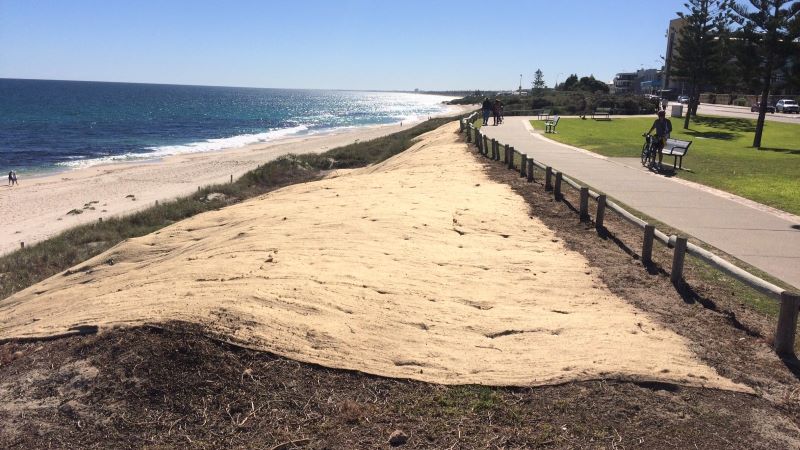
2016 Start of the project with biodegradable matting laid.
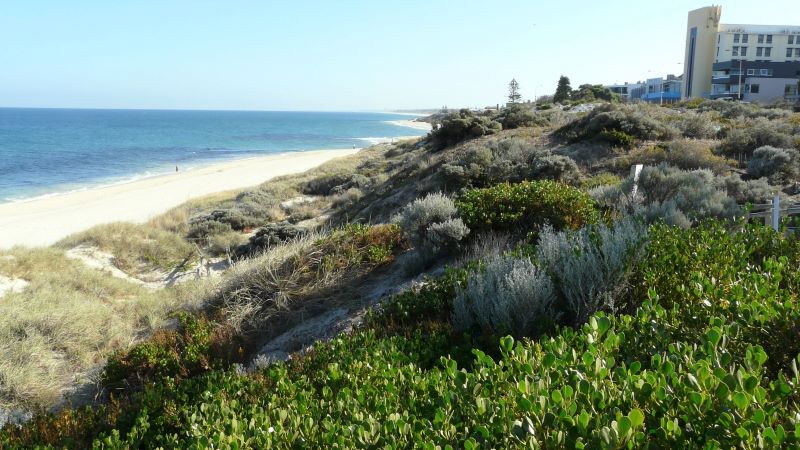
2019 Plants are growing well.
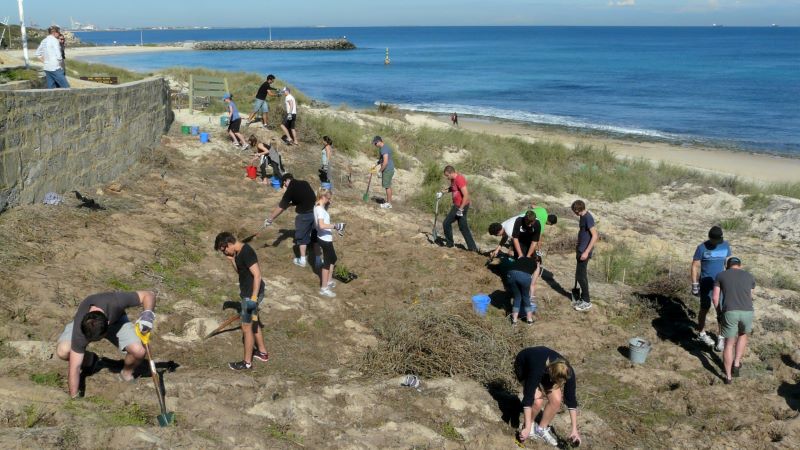
2013 Price Waterhouse Coopers joined us in a big planting session.
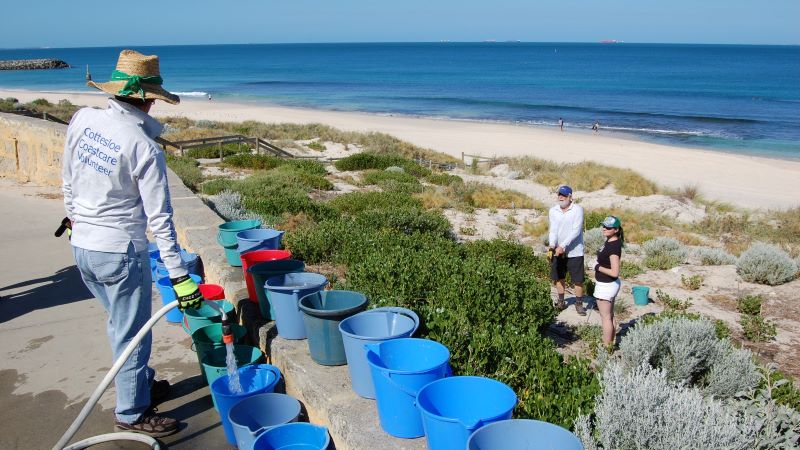
2014 Summer watering to keep the plants alive.

Summer seed collection for next year’s seedlings.
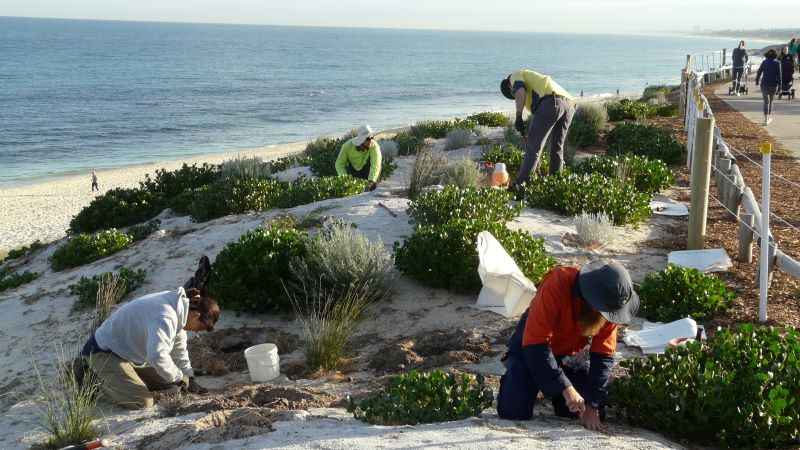
2017 Infill planting.
What we are protecting
White-winged Fairy Wren
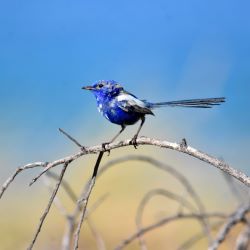
Until recently White-winged Fairy-wrens (Malurus leucopterus) had not been recorded in Cottesloe. Over the last few years small groups are moving south from Swanbourne through Cottesloe Coastcare’s restored foreshore sites. We are very excited about this development. They occur over the inland and arid coastal areas. The breeding male has striking cobalt blue colour and white wings. Females have sandy brown plumage with white underparts and have a pale blue-grey tail. The nests are built low in shrubs or grasses so cats present a great risk to the wrens.
Spinifex longifolius
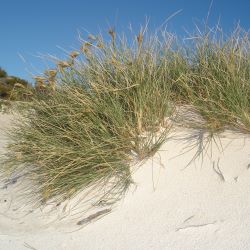
On this very windy and exposed site Spinifex provides a vital barrier at the foot of the dune. It is superbly adapted and can withstand salt spray and high winds, the long roots stabilise and hold the sand even in winter storms. The round seed heads are a common sight in high winds bowling along the sand. The most common species is Beach Spinifex (Spinifex longifolius) which spreads by seed and rhizomes. The plants can even withstand a severe degree of sand burial. Hairy Spinifex (Spinifex hirsutus) is not so common but its silvery grey, soft and hairy leaves stand out on the toe of the dune. It is another important primary colonising species of our coastal dunes.
Related stories
A prickly good news story
13 November 2019/by Sue FreethA successful 2018 planting season
21 July 2018/by Sue Freeth4000th plant in!
20 July 2017/by Sue FreethOur planting efforts have started brilliantly!
15 May 2016/by Robyn Benken2015 planting finished
17 June 2015/by Sue FreethSummer Sessions Summary
3 March 2015/by Sue FreethCoastcare for Singles May 2014
8 June 2014/by Robyn BenkenTwo more great teams of PwC planters
5 June 2013/by Robyn BenkenCottesloe Coastcare Association
PO Box 32
Cottesloe WA 6911
info@cottesloecoastcare.org
Sign up to our Newsletters
To stay up to date with our news and upcoming events.
